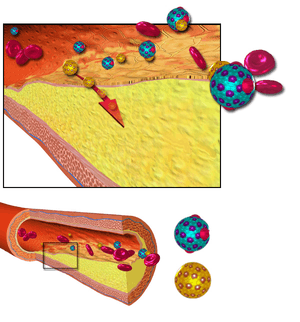Arteriosclerosis
| Arteriosclerosis | |
|---|---|
|
Blood vessel-plaque and cholesterol | |
| Classification and external resources | |
| Specialty | Pathology |
| ICD-10 | I25.0,I25.1,I70 |
| DiseasesDB | 1039 |
| MeSH | D001161 |
Arteriosclerosis is the thickening, hardening and loss of elasticity of the walls of arteries.[1] This process gradually restricts the blood flow to one's organs and tissues and can lead to severe health risks brought on by atherosclerosis, which is a specific form of arteriosclerosis caused by the buildup of fatty plaques, cholesterol, and some other substances in and on the artery walls.[2]
Signs/symptoms
Among the signs/symptoms of arteriosclerosis are: sudden weakness, facial or lower limbs numbness, confusion, difficulty understanding speech and problems seeing.[3]
Pathophysiology


The lesions of arteriosclerosis begin as the intima (innermost layer of blood vessel wall) of the arterial wall start to fill up with the deposition of cellular wastes. As these start to mature, they can take different forms of arteriosclerosis. All are linked through common features such as the stiffening of arterial vessels, thickening of arterial walls and degenerative nature of the disease.[4][5]
- Arteriolosclerosis, unlike atherosclerosis, is a sclerosis that only affects small arteries and arterioles, which carry important nutrients and blood to the cells.[6]
- Atherosclerosis is the narrowing of arteries from a build up of plaque, usually made up of cholesterol, fatty substances, cellular waste products, calcium and fibrin, inside the arteries. This affects large and medium-sized arteries; however, its positioning varies person to person.[7]
- Monckeberg's arteriosclerosis or medial calcific sclerosis is seen mostly in the elderly, commonly in arteries of the extremities.[8]
- Hyperplastic: Hyperplastic arteriosclerosis refers to the type of arteriosclerosis that affects large and medium-sized arteries.[9]
- Hyaline type: Hyaline arteriosclerosis, also referred to as arterial hyalinosis and arteriolar hyalinosis, refers to lesions that are caused by the deposition of homogenous hyaline in the small arteries and arterioles.[10]
Diagnosis
Diagnosis can be based on a physical exam, blood test, EKG and the results of these tests (among other exams).[3]
Treatment

Treatment is often in the form of preventative measures of prophylaxis. Drug therapy for underlying conditions, such as drugs for the treatment of high cholesterol, drugs to treat high blood pressure (ACE inhibitors),[11] and anti-coagulant drugs, are often prescribed to help prevent arteriosclerosis. Lifestyle changes such as increasing exercise, stopping smoking, and moderating alcohol intake are also advised.[3] Experimental treatments include senolytic drugs, or drugs that selectively eliminate senescent cells, which enhance vascular reactivity and reduce vascular calcification in a mouse model of atherosclerosis, as well as improving cardiovascular function in old mice.[12]
There are various types of surgery:
- Angioplasty and stent placement: A catheter is first inserted into the blocked/narrowed part of your artery, followed by a second one with a deflated balloon which is passed through the catheter into the narrowed area. The balloon is then inflated, pushing the deposits back against the arterial walls, and then a mesh tube is usually left behind to prevent the artery from retightening.[13]
- Coronary artery bypass surgery: This surgery creates a new pathway for blood to flow to the heart. Taking a healthy piece of vein, the surgeon attaches it to the coronary artery, just above and below the blockage to allow bypass.[14]
- Endarterectomy: This is the general procedure for the surgical removal of plaque from the artery that has become narrowed, or blocked.[15]
- Thrombolytic therapy: is a treatment used to break up masses of plaque inside the arteries via intravenous clot-dissolving medicine.[16]
Epidemiology
In 2008, the US had an estimate of 16 million atherosclerotic heart disease and 5.8 million strokes. Cardiovascular diseases that were caused by arteriosclerosis also caused almost 812,000 deaths in 2008, more than any other cause, including cancer. About 1.2 million Americans are predicted to have a heart attack each year.[17]
History
This phenomenon may have existed since ancient times; however, its diagnostics and clinical implications were not recognized until the 20th century. While many cases have been observed and recorded, the term arteriosclerosis was not used until Jean Fréderic Martin Lobstein coined it while he was analyzing the composition of calcified arterial lesions.[18]
Society and culture
The name comes from the Greek words αρτηρία, meaning artery, and σκληρωτικός, meaning hardened.[19]
References
- ↑ "arteriosclerosis" at Dorland's Medical Dictionary
- ↑ "NCBI - WWW Error Blocked Diagnostic". www.ncbi.nlm.nih.gov. Retrieved 2015-06-19.
- 1 2 3 "How Is Atherosclerosis Diagnosed? - NHLBI, NIH". www.nhlbi.nih.gov. Retrieved 2015-06-19.
- ↑ Rubin, Raphael; Strayer, David S.; Rubin, Emanuel (2011-02-01). Rubin's Pathology: Clinicopathologic Foundations of Medicine. Lippincott Williams & Wilkins. ISBN 9781605479682.
- ↑ "The Pathology of Atherosclerosis: Plaque Development and Plaque Responses to Medical Treatment - The American Journal of Medicine". www.amjmed.com. Retrieved 2015-06-19.
- ↑ Diehm, C.; Allenberg, J.-R.; Nimura-Eckert, K.; Veith, F. J. (2013-11-11). Color Atlas of Vascular Diseases. Springer Science & Business Media. ISBN 9783662062876.
- ↑ "Atherosclerosis: MedlinePlus". www.nlm.nih.gov. Retrieved 2015-06-19.
- ↑ Mohan, Harsh (2012-11-30). Pathology Practical Book. JP Medical Ltd. ISBN 9789350902660.
- ↑ "hyperplastic arteriosclerosis". Retrieved 2015-06-19.
- ↑ "hyaline arteriolosclerosis". Retrieved 2015-06-19.
- ↑ "ACE inhibitors: MedlinePlus Medical Encyclopedia". www.nlm.nih.gov. Retrieved 2015-06-19.
- ↑ Roos CM, Zhang B, Palmer AK, Ogrodnik MB, Pirtskhalava T, Thalji NM, Hagler M, Jurk D, Smith LA, Casaclang-Verzosa G, Zhu Y, Schafer MJ, Tchkonia T, Kirkland JL, Miller JD (2016). "Chronic senolytic treatment alleviates established vasomotor dysfunction in aged or atherosclerotic mice". Aging Cell. doi:10.1111/acel.12458. PMID 26864908. Retrieved 2016-02-15.
- ↑ "Angioplasty: MedlinePlus". www.nlm.nih.gov. Retrieved 2015-06-19.
- ↑ "Coronary artery bypass surgery". MedlinePlus.
- ↑ "Atherosclerosis -Treatment". UK NHS. Retrieved 21 November 2013.
- ↑ "Thrombolytic therapy: MedlinePlus Medical Encyclopedia". www.nlm.nih.gov. Retrieved 2015-06-19.
- ↑ "Atherosclerosis". Merck Manuals. Retrieved 13 February 2015.
- ↑ Mayerl, Christina. "Atherosclerosis research from past to present". National Center for Biotechnology Information. PMID 16612625.
- ↑ Copstead-Kirkhorn, Lee-Ellen C.; Banasik, Jacquelyn L. (2014-06-25). Pathophysiology. Elsevier Health Sciences. p. 322. ISBN 9780323293174. Retrieved 25 July 2016.
